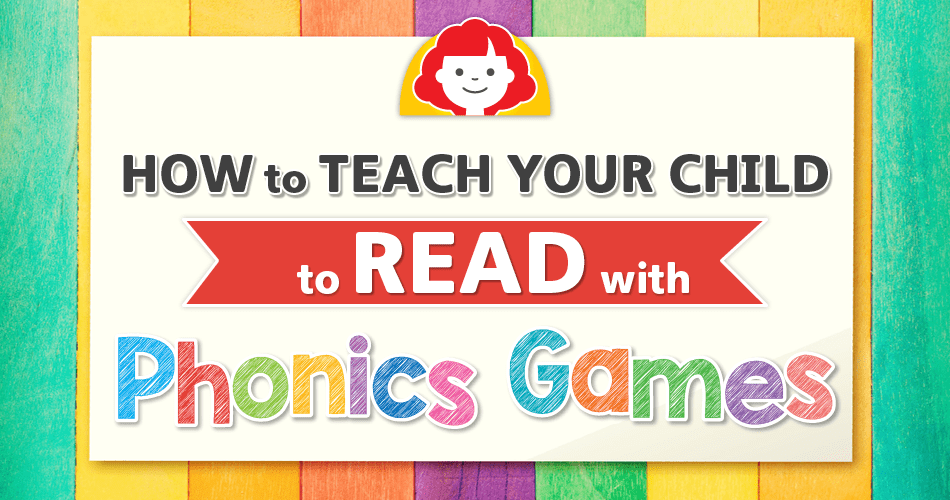
Teach your child to read by introducing phonics games and reading activities at home. Phonics plays an important role in teaching children to read. It helps children understand that certain letter combinations make specific sounds. Once children understand a specific phonics pattern (word family) they can identify new words that use that same word pattern. Practicing phonemic awareness at home helps children decode words and increases their word recognition, which ultimately increases their reading fluency.
Here are a few fun phonics activities and resources to try at home with your preschool, kindergarten, and first grade child.
1. Phonics Flip Book
Phonics flip books can be a fun way to teach sound and letter combinations. All you need is a wire-bound index card notebook, scissors, tape, and markers. You may design your flip book to practice three-letter words and sounds, blends, or word families. Word families help children identify common spellings and sounds in words. Tip: If your child only recognizes capital letters use capitals only. Incorporate lower case letters with uppercase letters when your child can identify them.
To make a blending flip book: 
- Divide and cut the notebook into three sections.
- Label the first, second, and last sections with letters A–Z. Place consonant letters in the beginning and end of the word and put a vowel in the middle.
- It is OK if your combinations don’t all make words. The purpose of this technique is to teach blending of sounds.

To make a word family flip book:
- Divide and cut the notebook into two sections.
- Label your first section with a blend such as: “fl, bl, cl, st, wh, ch, dr, or gr”
- Write your word family in the last section using patters like “at, ig, ake, ight, ing, ock, eep, or est.”
- Choose letters that form words with your word families.
2. Rhyming Phonics Game
Gather sets of rhyming objects to play the game “rhyme in a bag.” The objects should be small toys, stuffed animals or items you have around the house and in your toy bins. Place half in a paper bag and half on a table (pre-sort your objects so you have rhyming pairs in both places.) Have your child reach into the bag, pull out an object, and match it to an item on the table that rhymes. You can make it more advanced by adding word cards to pair with each object. Some examples of things you might find are:
- Pen, hen
- Sock, rock
- Cat, hat
- spoon, prune
- Rug, bug
- Glue, blue
- Tape, grape
Rhyming can help children understand that words that share common sounds often share common letters.
 3. Phonics Hopscotch
3. Phonics Hopscotch
Count word syllables with a hopscotch game. Using chalk or blue tape on carpet, outline the numbers 1–4 in the squares. Have children take turns counting out the syllables of a word using their feet. Understanding that words can be broken apart into syllables makes it easier for readers to decode as well as spell correctly.
4. Alphabet Hunt
An alphabet hunt is a fun and interactive way to teach letter and sound combinations. For beginning readers, matching objects with the same beginning and ending sounds reinforces this concept. Assign a letter of the week and have your child find objects in the house that have the same beginning sound as the weekly letter. If you use the letter C, have your child identify items that start with the hard “C” sound such as: couch, cushion, cat, carpet, calendar, clock, and candle. (The letter C can also make the soft “C” sound as in price and ice, but that is a lesson for first grade.) If your child chooses words that start with K, that is fine, too. This exercise is not about spelling words but about listening to the sounds they make.
5. Phonics 3 x 5 Card Games
 Make your own phonics games with 3 x 5 cards (or post-its), markers, paper clips, and paper bags.
Make your own phonics games with 3 x 5 cards (or post-its), markers, paper clips, and paper bags.
Spell It:
- Cut up a 3 x 5 card into 3 even squares. (You may also use post-it notes.)
- Pick a short three-letter word such as: cat, sat, bat, big, fig, pig, wig, rug, bug, hen, pen, men, mop, fox, box. Write one letter on each of the three squares. Give your child the pieces of the card with the letters mixed up.
- Have your child put the letters in order identifying the beginning, middle, and end sounds.
Tip: Work on words in the same word family such as the “at” family to help your child remember each letter pattern. Then, mix up word families so you pair “bat,” “rug,” and “mop” one right after the other. This will help you assess whether or not your child understands the “at,” “ug” and “op” word families. Clip your words together with paper clips and store them in a paper bag. (If you are using post-it notes you can stick the words together without the paper clips.)
Syllable Count:
- Using a 3 x 5 card, write a word with one, two, or three syllables such as goat, globe, snake, apple, dinosaur, lion, baby, balloon, pig, shoe, leaf, pajamas. (You may also draw or glue a picture of the word to the card to help your child learn the new word.)
- Label three paper bags with one syllable, two syllables, and three syllables.
- Pull out one of the words such as “goat” and read it with your child. Ask him or her to count the syllables in the word and put the card into the bag with the correct syllables. “Goat” is one syllable, so it should be placed into the bag labeled “1 syllable.”
- For a quick video lesson on syllables view this video from Scratch Garden.
Tip: Use clapping hands to teach your child syllable counts. Once your child has mastered these simple words you can make it harder with two-, three-, and four-syllable words such as tiger, flower, radio, calendar, tornado, potato, magazine, pencil, toothbrush, jacket, alligator and watermelon.
6. Phonics and Reading Activity Books
Include colorful phonics activity books, flashcards, and worksheets to reinforce your child’s learning.

Skill Sharpeners: Reading: Perfect for any age, Skill Sharpeners: Reading offers practice according to grade level. Find your child’s grade for age-appropriate reading and phonics practice for grades PreK–6.

About The Author
Heather Foudy is a certified elementary teacher with over 7 years’ experience as an educator and volunteer in the classroom. She enjoys creating lessons that are meaningful and creative for students. She is currently working for Evan-Moor’s marketing and communications team and enjoys building learning opportunities that are both meaningful and creative for students and teachers alike.
How to Teach Your Child to Read Using Phonics Games